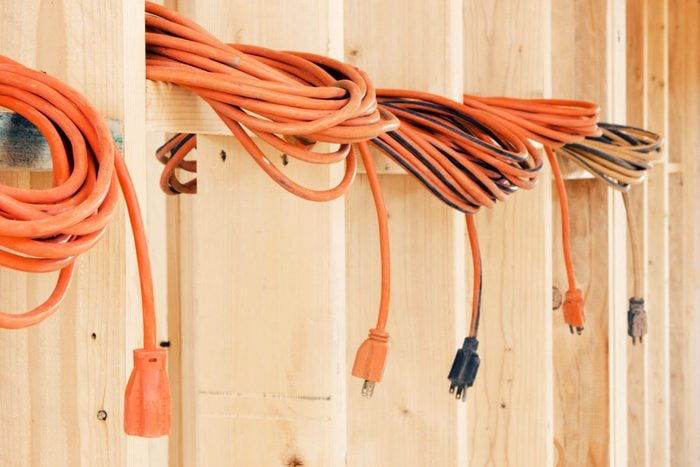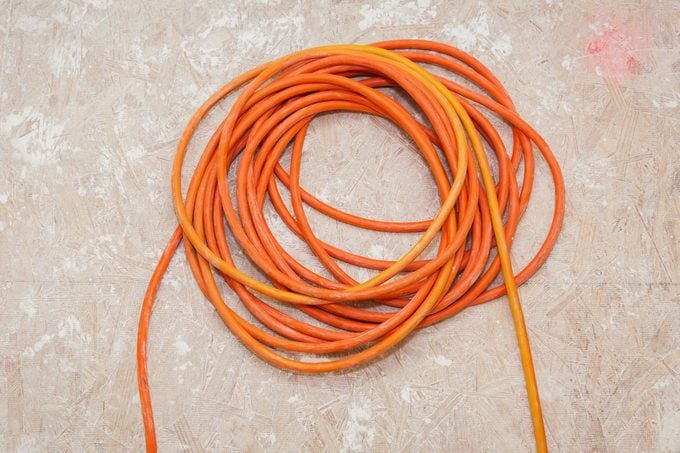How To Choose the Best Extension Cord for the Job
Updated: Dec. 03, 2023

Buying an electric extension cord? Keep a few important considerations in mind. Here's what to know.
Our editors and experts handpick every product we feature. We may earn a commission from your purchases.
Electric extension cords bring power where you need it, but they come in a dizzying array of choices. If you’re thinking about buying one but don’t know the first thing about them, here’s our handy guide.
On This Page
Terms To Watch For
Electrical jargon can be confusing, particularly if you’ve never bought an extension cord before. Here are some basics to know before you shop:
- Conductors: The wires that run through the extension cord, bringing electricity to your appliance or tool.
- Amperage: AKA “amps,” this measures the flow of electricity, and there’s a maximum limit that can safely travel through the conductors. Using a cord rated for too-few amps for the job can damage your cord, overheat your appliance or even start a fire.
- Voltage: This is the pressure or force that “pushes” the current through the cord. Household voltage in the United States is typically 120V, but extension cords will be rated 125V or higher to handle temporary fluctuations.
- Watts: This measures the power output of a tool, a function of amps and voltage. Look at the extension cord tag to find the maximum watts the cord can handle.
- Wire gauge: This number describes the diameter of the conductors. Wire gauge is listed as a number in American Wire Gauge (AWG), with 16 AWG, 14 AWG, 12 AWG and 10 AWG the most common extension cord wire sizes. They may also be written with a # sign (#12, etc.). The smaller the number, the larger the wire.
Types of Electric Extension Cords
Before you grab the first cord you see at the home center, know these basic extension cord types:
- Indoor: As the name suggests, extension cords intended for inside use only. These typically come in shorter lengths than outdoor extension cords and often have a two-prong plug.
- Outdoor: These come with a thicker outer jacket and a three-prong plug. Outdoor cords have the letter “W” printed on the cord, which stands for “weather,” as in weather-resistant.
- Indoor/outdoor: For use indoors or outdoors.
- Light-duty: Use these for lower-amperage, lower wattage tools and equipment, like indoor Christmas lights and portable fans.
- Medium-duty: These general-purpose cords are good for computers, vacuum cleaners and microwaves, depending on wattage.
- Heavy-duty: Contractor-grade cords feature beefy insulation and jackets, and often have 12 AWG or larger conductors. Use these for higher-amp, higher-watt tools, when working outside, or at long distances. Think table saws, air compressors, shop vacuums and the like.
What To Consider When Buying an Extension Cord
So, which cord should you buy? It’s easier if you’re buying one for a specific purpose. But if you’re buying one just to have it on hand, here are a few considerations to help you choose.
- Wire size: Undersized cords are worse than one that’s too big. If you’re only buying one cord, a 14 AWG extension cord is a good all-around choice for most applications at short distances. But always check the amps and watts of your specific tool before plugging in.
- Durability: Get one rated for outdoor use for more versatility. You can use an outdoor cord inside, but not the other way around.
- Length: Will you ever need a 200-foot extension cord? If you live in an apartment, probably not. Pick a practical length, but keep in mind you should never daisy-chain extension cords. One cord for one job, period.
- Cost: Longer, heavy-duty cords are much more expensive than shorter, medium-duty ones. Choose the cord that fits your budget, but don’t skimp on quality.
Choosing the Right Extension Cord

Most of us have a few extension cords of varying lengths and wire gauges lying around the garage or shop. How do you know which one to choose when you need one? Ask yourself these questions before grabbing the first extension cord you find:
How many amps does the tool draw?
Electrical devices, tools and appliances have known amperage requirements, printed on the tool or label. Computer chargers, toasters, miter saws, televisions, fans, vacuum cleaners — if it has a cord, it will tell you the amps it needs. (If you can’t find the info on the tool, check online.) If the tool lists watts but not amps, divide the watts by 120 volts to find the amps.
My miter saw draws 15 amps. An extension cord with 14 AWG conductors can carry 15 amps. So in general, a 14 AWG cord is fine. (The tool manual will tell you what cord to use.) But there’s a caveat, and an important one, explained below.
How far away is the job from the power source?
Let’s say I’m building a shed 50 feet from the nearest receptacle outlet, and I want my miter saw near the project site. Can I use a #14 cord? No.
Why does this matter? Aren’t extension cords designed to bring electricity to far-flung areas of your house and yard? Well, yes, but something happens to the voltage the farther away you get from the power source: It goes down. Too much “voltage drop” causes underperformance that can harm your tools.
Tool manuals, like the Ryobi above, and this one for a Ridgid compact router, not only tell you what cord to use in a normal scenario, but also how to combat voltage drop at longer distances. Use the shortest cord that will reach and handle the load. Go up to a heavier gauge if there’s any doubt.
Is the job indoors or outdoors?
Are you plugging in a reading lamp, or firing up the power washer to clean the driveway? Remember the amps discussion.
Those flat, two-prong extension cords with small-gauge wire work fine for a half-amp LED lamp, but use them sparingly, and never outdoors. Indoor cords, particularly the light-duty variety, often lack a grounding conductor, and the insulation and protective covering aren’t optimized for harsh weather or conditions.
When NOT To Use an Extension Cord
Sometimes you should not reach for an extension cord. If you find yourself in any of these situations, or you’re unable to protect the cord while using it, it’s time to invest in a long-term wiring solution. Never use an extension cord:
- Under carpet: Extension cords generate heat, especially when under load. Running a cord under carpets and rugs traps this heat and creates a fire hazard. Friction caused by foot traffic or furniture could also damage the cord, increasing the likelihood of fire or electrical shock.
- As permanent wiring: Don’t run any household appliance, lamp or equipment off an extension cord long-term. Extension cords, even rugged ones meant for heavy-duty use, are for temporary use only.
- Concealed in, or run through, walls and ceilings: Never hide an extension cord behind drywall or dropped ceilings. First of all, you’re likely to forget about them. And second, the heat buildup and unseen hazards increase your fire and shock risk.
- Where subject to physical damage: Extension cords are built to withstand some physical abuse. But if you’re stretching an extension cord across your garage or driveway to run a tool or lawn equipment, don’t allow vehicle traffic to run over it. This goes for any situation where the cord could be cut, frayed or otherwise damaged.
- With space heaters: Plug space heaters directly into the wall, never into an extension cord.
